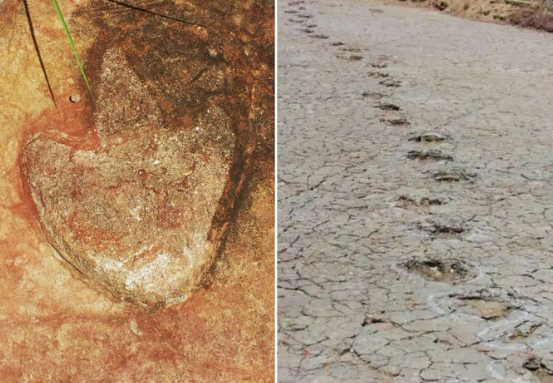A team of paleontologists discovered dinosaur footprints in Brazil and Cameroon that offer compelling evidence of a prehistoric connection between South America and Africa. Published in a recent study by the New Mexico Museum of Natural History & Science, these findings from the Early Cretaceous period illustrate how dinosaurs traversed freely across what was then a unified landmass.
Matching dinosaur footprints found more than 3,700 miles apart
READ Here :https://t.co/E4Nxtef8zP pic.twitter.com/xD92YxhfAe
— Rapid Radar News (@davidtong5751) August 27, 2024
Located more than 3,700 miles apart on separate continents, the over 260 studied footprints were impressed into ancient riverbeds and lakesides, indicating a shared geological and tectonic history. These prints, made by both carnivorous theropods and possibly herbivorous sauropods or ornithischians, date back 120 million years to a time when the continents were part of a giant supercontinent called Gondwana. This massive landmass had previously split from Pangea, the singular giant continent.
Louis Jacobs, a paleontologist from Southern Methodist University and the study’s lead author, explained the significant geological connection between northeastern Brazil and present-day Cameroon along the Gulf of Guinea. This narrow land bridge allowed for an intercontinental passage for dinosaurs between what are now vastly distant lands.
Matching sets of footprints discovered in Africa and South America reveal that dinosaurs once traveled along a type of highway 120 million years ago before the two continents split apart, according to new research. https://t.co/7BirMHzls8 pic.twitter.com/3ktGt5yMCy
— Roland (@rhow_lhand) August 26, 2024
As Gondwana began to fracture around 140 million years ago, the emerging South Atlantic Ocean filled the expanding divide, reshaping the continents’ coastlines and the natural world’s habitats. Rivers and lakes formed in these new basins, capturing the footprints of ancient life in their muddy sediments and documenting potential migration routes for these colossal creatures.
Researchers have discovered matching dinosaur footprints on separate continents, revealing insights into ancient migration patterns. The footprints provide evidence of a land bridge connecting South America and Africa over 120 million years ago. pic.twitter.com/O9fKVlyrpx
— Science In 60 Mins (@ScienceIn60Mins) August 26, 2024
Major Points:
- Paleontologists discovered matching dinosaur footprints in Brazil and Cameroon, demonstrating a prehistoric connection between South America and Africa.
- The footprints date back to the Early Cretaceous period and were found impressed into the mud and silt of ancient rivers and lakes.
- These findings suggest that dinosaurs could freely roam between the continents when they were still connected as part of the supercontinent Gondwana.
- The study highlights the geological and tectonic similarities between the footprints found over 3,700 miles apart, suggesting a shared environmental context.
- This research provides insight into the continental drift process, illustrating how the separation of Gondwana led to the formation of the South Atlantic Ocean and altered global ecosystems.
TL Holcomb – Reprinted with permission of Whatfinger News

